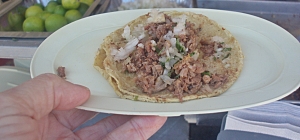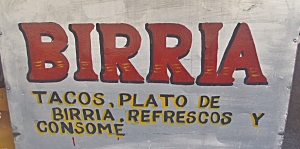To Don Day, birria was always something to get really excited about. Because birria was one of those Mexican dishes that Don Day had never tried. Ever in his life. As Don Day moves from the bottomless bucket list to the little pail used for sand at the beach list, it was as if he’d never have the matching shovel.
Oh, I’d looked. Hard. I’d had my eyes peeled on every trip in and out of San Miguel de Allende. Checking out every roadside restaurant and every temporary tarpaulin for that word birria. I’d gone from one corner of the Tuesday market to the other asking almost every single person who was cooking food if they sold birria. The answer was always no. I began to ask why and I almost always got the same answer. If you want birria, you’ve got to go to Jalisco.
Now Don Day used to go to Jalisco because Don Day used to go to Puerto Vallarta. And Puerto Vallarta is in the state of Jalisco. But in the years when Don Day went to Jalisco he was not in pursuit of regional Mexican specialties, he was in pursuit of imported specialties from other locales.
Then the other day, Don Day was on his way to El Pato, his favorite barbacoa spot, and just before he got there, just after he passed the bus station, he could just make out a sign from across the street with that word he had been searching for. There it was, that wonderful word. Birria.
Birria is a stew, traditionally a goat stew. The origin of the dish is one of the better folk tales of Mexico. In Celebrating Latin Folklore, Maria Herrera Sobek says, “…legend has it, the dish was invented by accident during the eruption of a volcano, when a shepherd was forced to abandon his goats in a cave only to return a few days later to find that the heat of the lava and the steam from the humidity in the cave had cooked them so perfectly leaving the meat tender and the skin crunchy. In face of this tragedy, he had the idea of collecting the meat and adding some hot sauce, thus creating the dish.”
The birria on Calzado de La Estacion in San Miguel de Allende is not a goat stew, nor it is made from lamb or mutton, the other meats commonly found in birria. No, this birria is birria de res, a beef stew. I asked Martin, the owner, chef, waiter and sole employee of the birria stand why beef.
“That’s the way I learned to make it”, said Martin, with a chuckle. “That’s the way I’ve always made it. That’s probably the way I’ll always make it.”
The rest of Martin’s birria recipe though is quite traditional. He marinates the beef in a puree of ancho and guajillo chile peppers and then simmers it in a broth with added spices for hours. When the meat is tender it is separated from the juices and stripped from the bones giving you two different things you can order, the meat or the consome made from the broth.
The first way to savor Martin’s burria is simply on a corn tortilla with Martin’s recommended onions, cilantro and a squeeze of lime. The second is with the consome as a dip for the meat-filled taco, slurping up what’s left when the taco is gone.
I asked Martin how it was possible to get beef so tender. He awkwardly twisted his arm and rubbed his hand along the side of his back. “It’s simply a matter of choosing the right part of the cow,” he told me.
Martin was indicating short ribs and along with shank and cheeks, short ribs are one of Don Day’s holy trinity of beef cuts if he wants deep, rich taste and melt-in-the-mouth tenderness.
Birria is traditionally eaten at Christenings, baptisms and weddings but, with its simple tastes, Don Day would recommend it more as a casual lunch dish or even just a snack (it’s now a just one more taco stop on Don Day’s way home from El Pato).
Is Martin’s burria stand therefore not a go-to destination restaurant. No, probably not unless you’re as epicurious as Don Day. There’s only one table and four chairs and the days and hours the stand is open are uncertain. But it’s definitely a stop-and-try-if-going-by restaurant and, as it’s just down the street, it’s one of the very few reasons Don Day knows to go to Mexico’s Walmart, Bodega Aurorra.
Except for one slight implication in the headline, there’s one more quite important thing about burria that I’ve so far avoided as I wrote this post. A vendor at the Tuesday market told me that if I went to Jalisco and particularly if I went to Guadalajara, the capital of Jalisco, I should watch for restaurants with a pair of goat horns or a goat’s head on a pole.
The icon has two meanings. The obvious being that goat meat and, in particular, birria is being sold in the restaurant. The other implication is that birria will, if you’ll excuse the expression, make you horny.
So I know your question. “Hey Don Day, does it work?” Well here’s a detailed account of what happened when I arrived home that afternoon after my first taste of burria. But I should warn you. Don Day’s Wife is also Don Day’s editor and if you find the next paragraph is simply an italicized account of where Martin’s burria stand is, she has obviously deleted it.
.
Martin’s birria stand is located on Calzado de la Estacion in San Miguel de Allende, Mexico. It is about 100 metres west of the station between two other restaurants, El Sotano (it’s easier to see its Bienvenidos sign on its awning) and Michelok’s. Bodega de Pisos y Banos is directly across the street. The stand is open on most late mornings and early afternoons. And when Martin’s not there, there’s no sign the food stand even exists.






Good one!
Date: Fri, 28 Feb 2014 15:58:08 +0000 To: peteross@sympatico.ca
Because goat is much more expensive than beef, you’re more likely to find birria made with beef in the Bajio. (Don’t believe everything you read in WIkipedia, really.)
Did you know that there’s the equivalent of a Mason-Dixon line in Mexico? Where the goat begins,the culture ends. While you can find goat just about anyplace, it’s a northern thing, and San Miguel de Allende is Bajio.
Birria is fairly easy to find in Morelia.